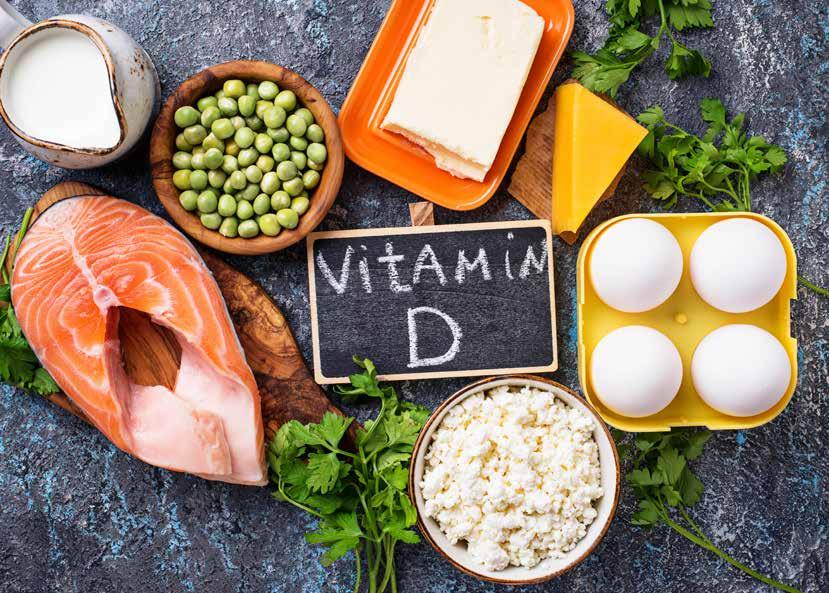
4 minute read
The Role of Vitamin D
Let’s take a look at the importance of vitamin D in maintaining children’s health, along with ways to increase their intake.
WHAT IS VITAMIN D?
Vitamin D is an essential nutrient that we need to build and maintain healthy, strong bones. Calcium is one of the main components of our bones. However, our bodies can only absorb calcium from food when vitamin D is also present. This makes it vital for everyone, but especially children, as their bones are still growing. Vitamin D is good for more than just bone health. It’s involved in many other processes within the body, even gene regulation. Being anti-inflammatory, neuroprotective and Vitamin D deficiency can stunt a child’s growth, cause muscle weakness, aches and pains, slow motor development and leave kids prone to bone fractures. It also leads to poor immune function and lower mental wellbeing - it really is an essential nutrient for children!
antioxidant, it plays an important part of a strong immune system, proper muscle function and a healthy brain.
WHAT IS DEFICIENCY?
Vitamin D deficiency is a health concern that affects around 1 billion people worldwide, with 1 in 2 people having less than the recommended amount. Because it is so common, it’s a good idea to keep a close eye on your child and make a deliberate effort with their diet and lifestyle to help them get the amount they need.
RISK FACTORS
Certain factors may make some kids more at risk for deficiency than others. Let’s take a look.
Skin characteristics
Darker skin tones have lots of melanin, which offers some natural protection from the sun. It also means that it takes lots more sun exposure for that child’s body to generate the needed levels of vitamin D. It’s estimated that this kind of skin needs up to fifteen times more sun exposure to produce the same amounts of vitamin D. This range is so big that you should choose your approach based on each individual child’s skin and this can even differ between siblings. Paler skin is sensitive to the sun, requiring much less time to synthesise vitamin D, but also far more at risk of burning and skin damage. Always be mindful of proper sun protection and your individual children’s skin characteristics.
Sun exposure
Unlike many vitamins, your child’s body has the ability to create vitamin D internally. However, kids need direct sunlight on their skin in order for their systems to make vitamin D. This is because the sun’s ultraviolet rays don’t penetrate clothes, glass, dense cloud cover or heavy amounts of air pollution. It’s also possible for your child to receive limited amounts of sun exposure, even in a country as hot as this, if they spend too much time indoors or don’t get enough sunshine on their actual skin. Sunshine is a really important source of this vitamin so it’s important to make use of it!
Body weight
The third of these factors is body weight. Studies have suggested that there is a close link between having a vitamin D deficiency and children with higher body fat compared to children with standard body fat levels, who did not have deficiency as commonly.
Trips abroad
Spending an extended period of time abroad in a colder climate can increase the likelihood of your child developing a deficiency, especially if their body is used to the sunshine here!
FOODS TO INCLUDE
It’s unlikely that your child will get as much vitamin D as they require from food by itself. That being said, it’s still a great idea to load up their diet with plenty of vitamin D rich foods to supplement what they’re getting from sunshine. Foods naturally containing vitamin D include:

✔ Oily fish like salmon, herring, mackerel or sardines
✔ Mushrooms
✔ Egg yolks ✔ Fortified breakfast cereals
✔ Fortified milk and dairy products ✔ Cod liver oil supplement
THE ROLE OF EXERCISE
Research indicates that kids who take part in regular exercise each week, like walking, running or cycling, tend to have better vitamin D levels. Encourage your kids to make the most of being out in the sun by doing some physical activity outdoors - a vitamin D double whammy!
TACKLING DEFICIENCY
If you have concerns about your child’s vitamin D levels or if you’re pregnant and think you might have low vitamin D, it’s best to visit your doctor. Your doctor can order a blood test, which is the most accurate way to check vitamin D levels.
If the deficit is mild, you might be advised that your child simply needs to get a bit more sun.
If the deficiency is more severe, you may be advised to give your child a vitamin D supplement, in addition to sunshine.
PREGNANCY AND BREASTFEEDING
Vitamin D is very important for pregnant women and those who are breastfeeding as the baby needs it for proper development. A baby’s vitamin D stores increase while they are growing in the womb but these levels go down after birth until the baby starts getting vitamin D from sunlight and diet. Breastfed babies don’t get much vitamin D from breast milk, as it doesn’t contain much. This is why it’s so important for a breastfeeding mum to keep her intake high. If her body is low on vitamin D, it’s more likely that she won’t be able to give enough of it to the baby. Infant formula contains more vitamin D, so formula-fed babies don’t usually need any supplementation. Using these foods and lifestyle tweaks, your child should be able to get plenty of this important vitamin! However, if you have any concerns or questions, speak with your doctor.










